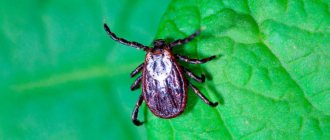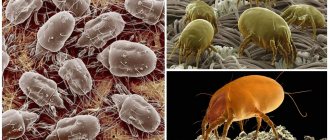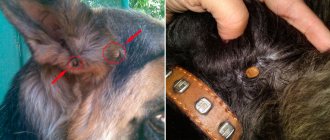A tick bite on a dog is fraught with many unpleasant consequences. Approximately 10% of infected animals die due to the fault of their owners. This occurs due to incorrect diagnosis and attempts at self-treatment. If you want to protect your pet from unpleasant consequences, be sure to familiarize yourself with the possible symptoms and first aid techniques.
Types of ticks and their level of danger
A tick is an arthropod arachnid that leads a parasitic lifestyle. It is often mistakenly classified as an insect. It's quite easy to remember their differences. Arachnids have an additional, fourth pair of limbs.
The arthropod occurs in 4 forms: egg, larva, nymph and adult. Only eggs are not adapted to self-feeding, so all other forms are dangerous for warm-blooded individuals and humans.
All known species are divided into 3 large groups:
- External
. They attach themselves to the outside of the body and are among the most dangerous. This group includes ixodic and encephalitic individuals that carry piroplasmosis, borreliosis and encephalitis.
- Subcutaneous
. They parasitize under the skin, penetrating into it from the external environment. Infection occurs locally or generalized, that is, it covers a certain area or the entire body of the animal.
- Intradermal
. They live inside the body in a dormant form from the moment of birth. They pose a danger when certain factors occur.
Ixodid ticks are held on to the fur by tiny spines covering 4 pairs of limbs. Their oval body is covered with a dark chitinous shell. While feeding, they cut the skin with teeth on their proboscis and inject an anesthetic. The body of the parasite, filled with blood, increases 3 times.
Subcutaneous include the white or yellowish-white sarcoptes scabiei, which causes sarcoptic mange, and the dirty gray notoedres, which causes notoedrosis (scabies). The size of these bloodsuckers does not exceed 0.45 mm.
The smallest representative is the subcutaneous demodex canis, which is light gray in color. The length of its cigar-shaped body is 0.2-0.3 mm. The parasite lives in the sebaceous glands and hair follicles.
Babesiosis in dogs (tick mite)
To begin with, a few words about terminology, because babesiosis is called both tick mite and piroplasmosis. Tick-borne babesiosis is called tick-borne disease for good reason: the disease is transmitted by ticks. But piroplasmosis is a somewhat outdated name (Piroplasma is a synonym for Babesia).
Tick insects in dogs can occur in acute, less often chronic or atypical form, and are characterized by fever, anemia, depression, yellowness of the mucous membranes, disorders of the nervous, cardiovascular systems, and digestive organ functions.
Babesiosis affects not only dogs, but also cows, horses, sheep, goats, pigs and other animals. However, Babesia species are quite “highly specialized”, that is, “cow” Babesia are not scary for dogs. Dogs, like other carnivores (cats, fur-bearing animals, wild carnivores), are susceptible to four species of Babesia: Babesia canis, Babesia gibsoni, Babesia vogeli, Babesia felis.
Causative agents of tick mites in dogs:
Babesia canis
- Babesia canis is a parasite of round, oval, pear-shaped, amoeba-shaped, most often paired pear-shaped, when the “pears” are connected by thin ends at an acute angle. It is the largest causative agent of babesiosis in dogs, up to 7 microns in length. It fills almost the entire red blood cell. One erythrocyte often contains 1-2 or several pathogens (less often – 16-32). Babesia canis affects 5-10% of red blood cells.
— Babesia gibsoni, Babesia vogeli are smaller in size than Babesia canis. They are oval or ring-shaped and do not exceed 1/8 of the diameter of a red blood cell.
— Babesia felis is a small parasite, 1.5-2.8 microns in size. Its body shape is round, oval, amoeba-shaped or cigar-shaped. One red blood cell contains from 1 to 4 red blood cells. Affects up to 10% of red blood cells.
What diseases do ticks carry?
If a dog is bitten by an uninfected tick, then its health is not in danger. But in cases where the parasite is a carrier of the infection, things become more serious.
A tick can carry not only the well-known borreliosis and encephalitis, but also other, less dangerous, but still unpleasant diseases.
Encephalitis
This is an inflammation of the brain, which often ends in the death of the infected person. The success of treatment depends on the strength of the immune system, as well as on the promptness of taking first measures. Symptoms of encephalitis in dogs include paralysis and convulsions, lethargy, loss of consciousness, and headache.
Borreliosis
The second name is Lyme disease. A dangerous neurological disease can cause complete or partial paralysis, as well as arthritis. The first signs are inflammation of the joints and, consequently, lameness. The dog is in pain, and this manifests itself in lethargy, decreased activity, and sometimes unfriendly behavior or whining.
Piroplasmosis (babesiosis)
Quite often, dogs avoid the first two dangerous diseases when bitten by a tick, but become infected with piroplasmosis. This disease is typical only for quadrupeds. The first manifestations are lethargy, shortness of breath, fever, vomiting or diarrhea, a little later jaundice is detected, the dog may experience pain in different parts of the body.
Bartonellosis
An extremely unpleasant disease that can be fatal if it is asymptomatic. But most often it manifests itself with the following symptoms:
- apathy, loss of appetite;
- temperature increase;
- inflammation - from external to internal;
- sudden weight loss;
- disruption of the heart;
- capillary hemorrhages;
- in severe cases - pulmonary edema.
With timely treatment, the disease can be completely defeated.
Ehrlichiosis
This is a hematological disease (imbalance of blood cells) that manifests itself in a high fever. It is also accompanied by other severe symptoms depending on the variety: hemorrhages and bleeding, fever, cramps, inflammation, etc.
Hepatozoonosis
The insidiousness of this disease lies in the fact that an animal can become a carrier without manifestations. As soon as his immunity weakens, hepatozoonosis will manifest itself with fever and discharge from the eyes. They may be accompanied by severe pain in muscles and joints.
Consequences of a tick bite on a dog
The consequences of a parasite bite do not appear immediately. The pet owner may not even notice how the tick bit his four-legged friend and fell off after a few hours. Even if the tick was quickly removed after detection, this will not guarantee that the infectious agent did not have time to enter the bloodstream. Often, the owners don’t even know why the animal suddenly becomes lethargic and dies a few days later. Therefore, you should remember the symptoms of dangerous diseases that can be used to diagnose your pet’s condition.
There are a number of diseases transmitted from ticks to animals:
- Bartonellosis is a dangerous disease that manifests itself after several years. The animal dies suddenly without any reason. In some cases, the disease passes without symptoms, but fever, anemia, and weight loss are often observed.
- Hepatozoonosis – pathology appears when a tick is swallowed. Signs do not bother you until the animal’s immunity weakens. As soon as a failure occurs in the immune system, there is a fever, pain in the body, and fluid is released from the eyes.
- Borreliosis (Lyme disease) - manifests itself two weeks after the parasite bite. Weakness and fever develop. The disease is transmitted through the mother to the puppies, so the fetus dies before birth.
- Piroplasmosis – occurs quite often, the disease manifests itself in the form of severe thirst and loss of appetite.
An ordinary bite does not pose a threat to the life of the animal. If the parasite is a carrier of the disease, then there is a high probability that the saliva will immediately enter the bloodstream and infection will occur, so treatment should be started in a timely manner. If a neurotoxic reaction occurs, it leads to tick paralysis. The animal may lose sensation in its hind limbs.
Can a person become infected?
Not only four-legged animals, but also humans can become infected from an arachnid. The list of the most dangerous diseases includes encephalitis and Lyme disease (borreliosis). They cause irreversible neurological changes that can only be treated in the early stages.
It should be noted that the diseases mentioned are dangerous for people, but they are not transmitted from dogs to humans. The risk only arises when an infected tick brought by a dog bites a person. Therefore, anti-tick treatment of your pet should be carried out in completely covered clothing.
Rare types of encephalitis can be transmitted through saliva and other secretions of an animal. But usually tick-borne encephalitis is contracted only from a parasite bite. Borreliosis is not transmitted at all from animals to humans.
A less dangerous disease, ehrlichiosis, can also occur in humans and dogs when bitten by a tick, but they cannot become infected from each other.
But the scabies mite easily travels through the air between all mammals. Therefore, it is recommended to isolate a dog infected with a subcutaneous tick from other residents, and treatment measures should be carried out wearing gloves and special clothing.
Symptoms and signs of a bite
Most often, a tick bite in a dog causes burning and itching. More severe symptoms are explained by an infection transmitted through the parasite's saliva or a weak immune system. The resulting reactions are divided into 3 groups:
- Are common
. Problems with coordination arise, bowel movements are disrupted, activity and appetite decrease. The dog is constantly itching.
- Local
. Symptoms of a tick bite in a dog include swelling, redness or purulent inflammation, itching and pain at the site of the insect's attachment, and an increase in local temperature.
- Neurotoxic
. After a tick bite, a dog develops “tick paralysis.” The hind and front legs begin to fail, the swallowing reflex is disrupted, shortness of breath appears, and the volume and audibility of barking decreases. Without timely assistance, the animal dies from suffocation due to spasm of the larynx.
The signs that appear depend on the type of arachnid; you can see them in more detail in the example table.
| View | Symptoms |
| External |
|
| Subcutaneous |
|
| Intradermal |
|
The most dangerous signs of a tick bite in a dog are a change in the color of the urine and the appearance of seizures.
The first sign indicates piroplasmosis, and the second sign indicates encephalitis. If an animal becomes infected with one of these diseases, it must receive medical attention within 2-5 days. Otherwise it dies.
Symptoms of piroplasmosis after a tick bite
Most often, pets become infected with piroplasmosis from ticks. The virus develops within a day or two. How long it takes for infection to occur depends on the age of the pet and the date of vaccination. The first stage of piroplasmosis is manifested by fatigue, apathy and loss of appetite. If the disease was detected in the early stages of development, then the disease can be cured in a few days.
At an advanced stage, a high temperature of up to 42 degrees, urine with blood, and an unpleasant odor from the pet’s mouth occur. Shortness of breath, vomiting, and yellowness of the eyeballs may occur. If the pet is in serious condition, then the symptoms of the first and second stages are combined together. Convulsive attacks, loss of coordination are noticed, and the paws may even fail.
In a severe stage, it is rarely possible to save a pet. The duration of treatment is up to three weeks. Convulsions can lead to swelling of the brain, then the dog will die.
Causes of infection and possible consequences
External and subcutaneous mites are transmitted by contact with an infected mammal or contaminated items. The risk group includes puppies, elderly dogs, animals with chronic diseases and purebred pets with a good pedigree. The consequences of a tick bite in dogs from this group are always more severe.
Intradermal arachnids that cause demodicosis become pathogenic when the immune system is sharply weakened. This occurs when the following factors
:
- pregnancy and childbirth;
- stress and mental disorders;
- estrus;
- docking of ears or tail;
- recent surgeries;
- change of teeth;
- long-term use of antibiotics;
- poor quality nutrition;
- hypothermia or overheating of the body;
- infectious and autoimmune diseases.
Demodex canis is often seen in German Shepherds, Great Danes, Boxers, Afghan Hounds, English Bulldogs, Collies, Doberman Pinschers, Dachshunds, Bobtails, Cocker Spaniels and Chihuahuas. The disease is transmitted from mother to puppies, but is not considered dangerous to other animals or humans. Notoedres and sarcoptes scabiei are also considered safe. They are not able to reproduce on human skin.
Demodicosis manifests itself in 2 forms: scaly and pustular. In the first case, redness and cracks appear on the skin, in the second - pustules and ulcers. Symptoms of the disease are observed only in one place, but if left untreated, they spread to neighboring areas. The resulting wounds attract pathogenic microorganisms. Possible complications include sepsis from a secondary infection, which reduces the chances of recovery by up to 50%.
Symptoms of a tick bite in a small breed dog are more pronounced than in larger animals. The effects of a neurotoxic reaction develop more quickly in small dogs. If an encephalitis tick has bitten a Spitz or Toy Terrier, then immediately seek help from the nearest veterinary clinic.
Other dangerous consequences include the following diseases: ehrlichiosis, hepatozoonosis and bartonellosis. They can be recognized by a delayed reaction, the appearance of purulent discharge from the eyes or bleeding from the nose. All these signs appear in late stages and are difficult to treat.
First aid for a dog with a tick bite
When a tick is detected, first aid is provided: the parasite is picked up with tweezers, screwed in together with the head, and after removal it is burned. It is best to do this with gloves to avoid infection. A dog's skin wound must be disinfected. If the condition worsens, contact your veterinarian immediately. Before the specialist arrives, the dog is given clean water. If vomiting occurs, an enema is given or a subcutaneous injection is given.
If a dog is bitten by an encephalitis tick, the animal may die if help is not provided. Infection occurs quickly as the brain and nervous system are affected. At the first symptoms, the dog is taken to the clinic. After a bite, the pet becomes lethargic, the temperature rises, and there is no appetite. A white coating may appear on the mucous membranes. In such cases, the animal needs urgent help, since brain damage occurs quickly.
What should the owner do?
A tick bite on a dog is always accompanied by licking of the wounds left by the parasite's proboscis. If you are sure or at least suspect an infection, contact your veterinarian. Dosages of acaricidal drugs used to combat arachnids are selected individually. Self-treatment is unacceptable. Most animals left without qualified help do not survive.
First aid and diagnostics
Most often, parasites attack weakly protected areas: the hind and front legs, armpits, ears, groin and abdomen. A bloodsucker that has eaten its meal grows to the size of a large bean, so it is easy to notice upon detailed examination.
If you are providing first aid to your dog for a tick bite, wear protective gloves. Do not forget that small arachnids are dangerous not only for your four-legged pet, but also for its owner.
For safe removal, a set of Tick Twister tweezers will be useful. This tool removes the attached parasite with minimal risk. If you don’t have tweezers at hand, you’ll have to do it the old fashioned way. For this you will need:
- Fingers
. Everyone has it, so there shouldn't be any problems. Wrap them in a clean cloth or bandage. Grasp the body of the arthropod in the place where it is attached and twist it in a certain direction. Move clockwise or counterclockwise without changing the original order.
- Tweezers from a manicure set
. Grab the body of the parasite where it enters the skin, placing the tips of the instrument horizontally. Without loosening your grip, begin to twirl the tweezers. Avoid direct upward pulls. After successful extraction, treat the wound with an antiseptic.
If a tick has bitten a dog, then it can only be helped with the tools listed above. Kerosene, oil or gasoline form an impenetrable film or caustic vapor. The arachnid dies from lack of oxygen or poisoning immediately after transmission of the infection. Thread loops are also prohibited. Due to the tension, the tick often loses its head, so it has to be searched for and removed with a heated needle.
Within 2 days, the insect can be transferred to a veterinary clinic for detailed diagnosis. For this, a tightly closed jar with wet cotton wool inside is useful. If you do not have the specified time, burn it, scald it with boiling water, or simply crush the insect between several layers of thick paper.
After first aid, rush to the veterinarian for diagnosis. Immediately after a tick bite, your dog should not be given antipruritic medications. They will distort the clinical picture and prevent the correct diagnosis. Relieving itching with the help of drugs is only permissible if the victim cannot be taken to the clinic on the day of infection.
At the veterinary clinic, a visual examination and medical history is taken. After becoming familiar with the individual factors that can influence the development of the disease, the doctor takes a blood and urine test. Their study determines the presence of toxins released during the life of parasites. Scraping is used to identify their type, and ultrasound and x-rays are used to track internal pathologies.
The duration of treatment depends on the type of disease, degree and duration of infection.
Features of treatment
The recovery period takes from 4 to 8 weeks. Therapy is based on detoxifying the body and eliminating secondary infections. Drug treatment includes taking:
- antihistamines that relieve itching;
- minerals and vitamins that stimulate the immune system;
- acaricidal drugs that act directly on parasites;
- hemostatic agents;
- diuretics that remove accumulated toxins;
- hepatoprotectors that ease the load on the liver.
A tick bite on a dog, accompanied by severe intoxication, requires a mandatory blood transfusion.
When handling a pet infected with notoedrosis or sarcoptic mange, you will need protective gloves. After handling this medication, wash your hands thoroughly. Acaricidal drops are always instilled into both ears, even if only one is affected.
If affected by demodicosis, the pet is discarded from breeding and sterilized. Regardless of the form of the disease, the dog is cut and treated with peroxide. After cleansing, wash it with antiseborrheic shampoo. The scheme for subsequent treatment of ulcers and suppurations is agreed with the veterinarian. This disease is characterized by relapses. Visit the veterinary clinic for preventative purposes at least 2 times a year, even after recovery.
In addition to drug treatment, it is necessary to limit physical activity. Daily walks at a slow pace are welcome, but intense training will have to be abandoned until complete recovery.
During treatment, a gentle diet is recommended. Fatty and heavy foods are prohibited. The diet is based on oatmeal, chicken fillet and beef tenderloin. All food should be at room temperature. Avoid reheating. Familiar delicacies are replaced with rosehip decoction.
Of all the diseases considered, only the extreme stage of encephalitis, accompanied by extensive inflammation of brain tissue, cannot be treated. The only humane solution to such an infection is euthanasia.
Symptoms of infection
The incubation period is the time when parasites actively reproduce. It lasts from 3 days to 4 weeks. Its development and duration depends on many factors:
- The dog’s age and health status at the time of the tick bite;
- The number of Babesia in the blood;
- Was vaccination carried out?
There are acute and chronic courses of the disease. Symptoms of acute piroplasmosis can be divided into two categories.
Primary signs:
- Frequent breathing and heartbeat;
- Weakness and lack of appetite;
- Body temperature rises to 42 degrees;
- Darkening of urine, bloody impurities, brown color;
- Diarrhea, vomiting.
These symptoms may appear as early as the third day after the tick bite. If the owner does not react and does not take the pet to the doctor, then the final signs of piroplasmosis will not be long in coming.
Final signs:
- The mucous membrane of the eyes acquires a yellow or blue tint;
- Yellowness of teeth in the most severe cases;
- Lack of appetite and watery stools that are jaundiced or green in color;
- Complete or partial numbness of the back of the body, rare spasms.
If you do not seek help from a veterinarian in time, death is possible within 3-7 days.
The danger of a chronic disease lies in its mild symptoms. The disease is indicated by the dog's constant depressive state. Then the dog’s health worsens: constipation alternates with diarrhea. Anemia progresses, the dog gets tired quickly and eats poorly. In this case, a blood test will show a decrease in red blood cells.
The chronic form of the disease is rare and occurs only in those dogs that have already suffered piroplasmosis once or have a strong immune system. In this situation, the disease lasts from 3 to 8 weeks. With proper treatment, the tailed pet recovers only after 3-6 months.
Diagnosis of the disease
To identify a dangerous disease, specialists conduct complex diagnostics. The correct diagnosis is confirmed based on examination and laboratory tests:
- Biochemical blood test;
- Serological research;
- Ultrasound of the kidneys;
- Urinalysis (to detect the presence of hemoglobin).
In advanced cases, the color of urine is almost black. This is due to severe damage to red blood cells. The tests may need to be repeated in a few days. After all, during the incubation period it is not always possible to immediately detect the presence of parasites in the blood of an animal.
Prevention recommendations
Infection cannot be ruled out, but the risk can always be reduced. Important for your pet's health
:
- Don't neglect vaccination. Passive immunity lasts for six months. Even if infected, a vaccinated individual will tolerate the disease more easily.
- Limit communication with unfamiliar four-legged animals. Most often, stray dogs and wild animals become carriers. And playing with a fluffy squirrel is fraught not only with invasion, but also with rabies.
- Carefully inspect hard-to-reach places on your body after each walk. The speed at which the first symptoms appear varies from person to person. If no signs are found, then repeat the skin examination after a couple of hours.
- Control your diet. A proper and balanced diet is the key to a strong immune system.
- Contact a veterinary clinic for help with any questions or suspicions. It is better to make mistakes several times than to lose your beloved dog due to carelessness.
- Use anti-tick agents during periods of increased parasite activity: from April to October. If the dog has long hair or profuse sweating, which requires frequent washing, increase the recommended dosage of medications.
- Avoid mating if infestations are detected. Feel free to ask for information from the second owner.
- Sterilize after infection with subcutaneous parasites. Not only future offspring can suffer, but also the bitch herself. Relapse of the disease occurs against the background of any hormonal changes.
Antiparasitic agents include vaccines, collars, sprays and drops. Each of them has its own advantages and disadvantages.
Vaccine
Giving your pet a vaccine will reduce the likelihood of infection. The most popular include “Nobivak Pro” and “Pirodog”. These vaccines protect against piroplasmosis. Only healthy animals are allowed to be vaccinated. Vaccination after infection is pointless.
To consolidate the result, a second vaccination is given 1 month after the first vaccination. All subsequent ones are done once every six months independently or in a veterinary clinic.
Collars
Collars last for more than six months, but often cause local allergic reactions. If your pet's hair falls out, you will have to abandon the collar in favor of drops or sprays.
Due to the ingredients included, the collars are not suitable for nursing or pregnant women, puppies under 2 months of age, or animals with chronic illnesses.
The smell emitted by the product repels insects and remains on the body for some time even after removal. According to the method of exposure, they are chemical, biological and ultrasonic. The first two are repelled by the smell of chemicals or essential oils, and the last one is repelled by ultrasound, which is detected only by arachnids. An ultrasonic collar is more expensive than its analogues, but is considered safer.
Drops and sprays
Sprays and drops have fewer restrictions than collars, but they are inferior in convenience and cost-effectiveness. For long-haired breeds you will have to use double the amount of product. Both drops and spray wash off easily, so be sure to renew the protective layer after each wash.
Drops are more convenient than spray, since they can only cover the withers, and not the entire body.
Diseases carried by ticks are transmitted not only to pets, but also to their owners. Be vigilant when walking in tall grass and do not forget about preventive measures. For added protection, purchase a jumpsuit. With it, the pet will be less attractive to bloodsuckers, since protective clothing will make it difficult to access the most desirable parts of the body.
The article is for informational purposes only. Contact your veterinarian!











